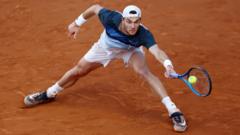As the French Open approaches, we explore the essential skill sets and traits required to excel on the demanding clay surface. Focusing on Jack Draper’s advancements and insights from tennis legends, we highlight the importance of fitness, spinning shots, sliding movement, and early exposure to clay-court play for aspiring players.
The Ingredients for Success on Clay: What Makes a Top Clay-Court Player?

The Ingredients for Success on Clay: What Makes a Top Clay-Court Player?
With the upcoming French Open in sight, we analyze the key qualities defining successful clay-court players, drawing insights from rising star Jack Draper's journey and the unique challenges of this surface.
With the French Open 2025 on the horizon, tennis fans are eager to see how British players will perform, especially given the country's limited history of success on clay courts outside of Andy Murray. Rising star Jack Draper, who recently reached the Madrid Open final, is making his mark as a formidable competitor on this challenging surface.
Historically, the French Open has not yielded many singles triumphs for the British. While Andy Murray reached the finals in 2016, the last British singles champion was Sue Barker in 1976. In contrast, last year's tournament saw all six British players eliminated in the first round, a stark reminder of the difficulties faced. However, hope springs eternal with Draper's recent achievements prompting discussions about what it takes to thrive on clay.
Key components for success on clay include superior fitness and stamina. The slower-paced clay allows for longer rallies, demanding players to possess both endurance and speed. For instance, Iga Swiatek, a four-time French Open champion, exemplifies this with her impressive court coverage and swift recovery times, which enable her to set up aggressive forehands. Draper's commitment to fitness training has significantly contributed to his clay-court improvements, as evident from his grueling matches in the Australian Open and his persistence following fatigue during the Italian Open.
Moreover, impactful shot techniques, particularly hitting with spin, play a crucial role in clay success. Rafael Nadal's legendary forehand showcases how heavy topspin can disrupt opponents by pushing them behind the baseline, making shot placement critical. Former champion Michael Chang emphasized Nadal's finesse in manipulating the court's angles, underscoring the blend of aggression and patience needed on clay.
Equally important is mastering sliding and movement, which can prevent players from falling behind in rallies. Draper and his colleague Jacob Fearnley prioritized sliding practices at the National Tennis Centre, a crucial skill given the unique aspects of clay courts. Proper sliding allows for returning defensive shots more effectively while preparing for more aggressive plays.
Despite their challenges, British players are gaining valuable experience on clay. The Lawn Tennis Association (LTA) is expanding its partnerships with clay-court facilities in Spain to refine the training of young talents. Historically, the UK has a limited number of clay courts, and the financial upkeep can deter clubs from maintaining such facilities. Moreover, there has been reluctance among young players to travel abroad for training, a path Murray undertook in his youth.
In light of these factors, it is clear that successful clay-court players like Jack Draper combine rigorous training, strategic skill sets, and early exposure to the game. As they prepare for the upcoming French Open, their dedication and resilience may indeed turn the tides for British tennis on clay.









